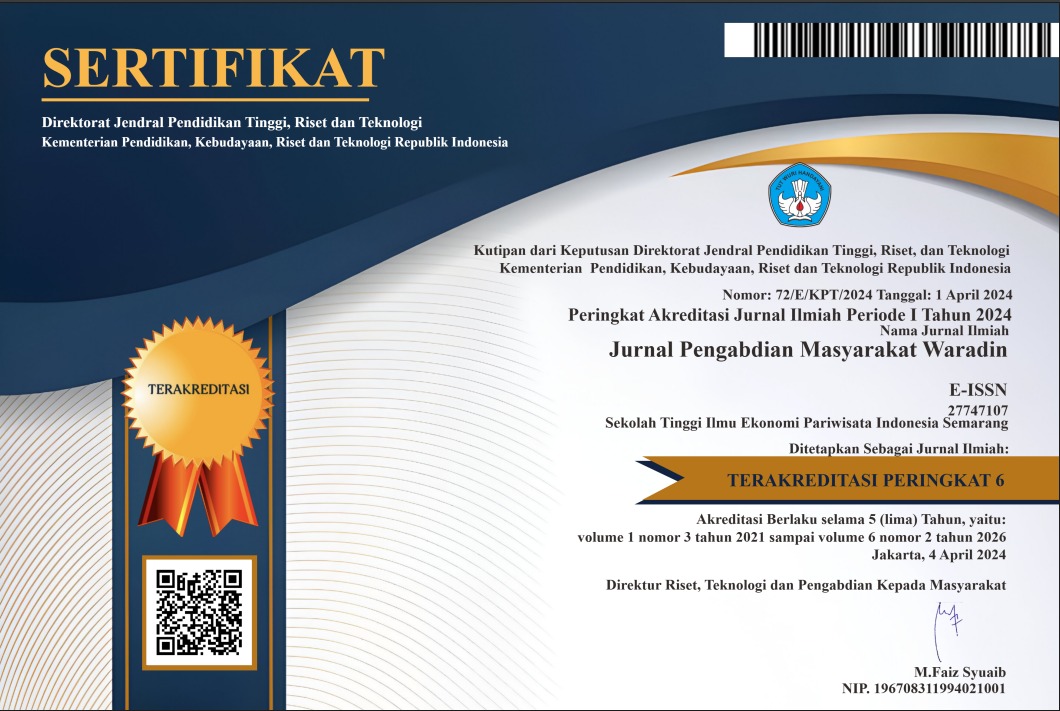Penerapan Good Agricultural Practice (GAP) untuk Peningkatan Teknologi Pengelolaan Ternak dan Tanaman pada KTH Berbasis Agrosylvopastura di Desa Paopao, Kabupaten Barru
DOI:
https://doi.org/10.56910/wrd.v5i1.434Keywords:
Agroforestry, Agrosylvopastura, Cattle Farming, Complete FeedAbstract
Paopao Village, Tanete Rilau District, Barru Regency, is one of the centers of cattle farming, as well as one of the sub-districts that received an allocation of Limited Production Forest management so that community groups who are members of the Forest Farmer Group (FFG) can apply the Agroforestry agricultural pattern, which was later developed into an Agrosylvopastura pattern with the management of animal feed crops. During this time, traditional livestock breeding communities still rely on natural feed and plant waste which is increasingly difficult to obtain,in extreme climatic conditions. Plant management in the Agroforestry system is also not optimal. The Community Empowerment Activity implements training and counseling activities as well as a demoplot of Agroforestry management management based on the application of environmentally friendly and sustainable Good Agriculture Practice (GAP) principles in Paopao village, to increase Agroforestry yields. The method applied at this stage of activities is through the principle of learning by doing, starts from Problem Identification, Planning and Implementation program, and Evaluation of Success and Assistance for Sustainability. In addition to being equipped with knowledge of the implementation of GAP Principles, a demonstration plot for breeding and maintaining Indigofera sp. feed plants, as well as the practice of making complete cattle feed (Complete Feed) so that the community is able to process various natural ingredients into a complete feed formulation. Community empowerment was improved through counseling and training on livestock and crop management. Successful activities increase community knowledge in managing Agroforestry and Agrosylvopastura in an integrated manner based on GAP, as well as the technical ability to make complete feed formulations for cattle in a sustainable manner.
References
Akbarillah, T., Kususiyah, K., & Hidayat, H. (2010). Pengaruh penggunaan daun Indigofera sp. segar sebagai suplemen pakan terhadap produksi dan warna yolk itik. Jurnal Sain Peternakan Indonesia, 5(1), 27-33. https://doi.org/10.XXXX/XXXX (ganti dengan DOI jika tersedia)
Baba, S., Muktiani, A., Ako, A., Sanusi, A., & Dagong, I. A. (2012). Produksi complete feed berbahan baku lokal dan murah melalui aplikasi participatory technology development guna meningkatkan produksi dangke susu di Kabupaten Enrekang. Laporan Insentif Riset Sinas. Universitas Hasanudin.
Litbang Pertanian. (2021). Good agricultural practices sebagai perangkat lunak pertanian modern. Balitkabi. https://balitkabi.litbang.pertanian.go.id/berita/good-agricultural-practices-sebagai-perangkat-lunak-pertanian-modern/. Diakses pada 24 Juli 2024.
Nahraeni, W., Masitoh, S., Rahayu, A., & Awaliah, L. (2020). Penerapan good agricultural practices (GAP) jeruk pamelo (Citrus maxima (Burm.) Merr.). Jurnal Agribisains, 6(1), 50-59.
Rosyady, M. G., Setiyono, S., Subroto, G., & Savitri, D. A. (2022). Pengembangan desa sentral kakao berkelanjutan melalui penerapan good agriculture practices (GAP). PaKMas: Jurnal Pengabdian Kepada Masyarakat, 2(2), 279-283.
Shofi, A. S., Agustina, T., & Subekti, D. S. (2019). Penerapan good agriculture practices (GAP) pada usahatani padi merah organik. JSEP, 12(1), 1-8.
Sriyadi, S., Istiyanti, E., & Fivintari, F. R. (2015). Evaluasi penerapan standard operating procedure-good agriculture practice (SOP-GAP) pada usahatani padi organik di Kabupaten Bantul. AGRARIS: Journal of Agribusiness and Rural Development Research, 1(2), 78-84.







